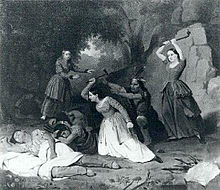Hannah Duston: Difference between revisions
Hantsheroes (talk | contribs) |
Hantsheroes (talk | contribs) No edit summary |
||
| Line 3: | Line 3: | ||
[[File:Hannah Duston, by Stearns.jpg|thumb|''Hannah Duston'' by [[Junius Brutus Stearns]]]] |
[[File:Hannah Duston, by Stearns.jpg|thumb|''Hannah Duston'' by [[Junius Brutus Stearns]]]] |
||
'''Hannah Duston''' ('''Dustin''', '''Dustan''', and '''Durstan''') (born Hannah Emerson, December 23, 1657 - c. 1736) was a [[Massachusetts Bay Colony|colonial Massachusetts]] [[Puritan]] woman who escaped [[Indigenous peoples of the Americas|Native American]] captivity by leading her fellow captives in [[scalping]] their captors at night. Duston is the first woman honored in the [[United States]] with a statue. |
'''Hannah Duston''' ('''Dustin''', '''Dustan''', and '''Durstan''') (born Hannah Emerson, December 23, 1657 - c. 1736) was a [[Massachusetts Bay Colony|colonial Massachusetts]] [[Puritan]] woman who escaped [[Indigenous peoples of the Americas|Native American]] captivity by leading her fellow captives in [[scalping]] their captors at night. Duston is the first woman honored in the [[United States]] with a statue. She has been referred to as the "mother of the American tradition of scalp hunting". <ref>John Grenier. The First Way of War. University of Cambridge Press. 2005. pp. 40-41</ref> |
||
==Biography== |
==Biography== |
||
Revision as of 06:59, 31 December 2011

Hannah Duston (Dustin, Dustan, and Durstan) (born Hannah Emerson, December 23, 1657 - c. 1736) was a colonial Massachusetts Puritan woman who escaped Native American captivity by leading her fellow captives in scalping their captors at night. Duston is the first woman honored in the United States with a statue. She has been referred to as the "mother of the American tradition of scalp hunting". [1]
Biography

During King William's War, Hannah, her husband Thomas Duston, and their nine children were residents of Haverhill, Massachusetts in March 1697 when the town was attacked by a group of Abenaki American Indians from Quebec. (In this attack, 27 colonists were killed and 13 were taken captive to be either adopted or or held as hostages for the French.) When their farm was attacked, Thomas fled with eight children, but Hannah, her newborn daughter Martha, and her nurse Mary Neff were captured and forced to march into the wilderness. Along the way, the Indians killed the six-day-old Martha by smashing her against a tree. Hannah and Mary were assigned to an Indian family group of 13 persons and taken north. The group included Samuel Lennardson, a 14-year-old captured in Worcester the year before. Six weeks later, at an island[2] in the Merrimack River at the mouth of the Contoocook River near what is now Penacook, New Hampshire, Hannah led Mary and Samuel in a revolt. She used a tomahawk to attack the sleeping Indians, killing one of the two grown men (the second was killed by Lennardson), two adult women and six children. One severely wounded Indian woman and a young boy managed to escape the attack. The former captives immediately left in a canoe, but not before taking scalps from the dead as proof of the incident and to collect a bounty.[3] They traveled down the river only during the night, and after several days reached Haverhill. The Massachusetts General Court later gave them a reward for killing Indians; Hannah Duston received 25 pounds, and Neff and Lennardson split another 25 pounds (various accounts say 50 or 25 pounds, and some accounts mention only Duston receiving an award). Hannah lived for nearly forty more years.
Legacy

The event became well known, due in part to the account of Cotton Mather in his Magnalia Christi Americana.[4] Duston became more famous in the 19th century as her story was retold by Nathaniel Hawthorne, John Greenleaf Whittier and Henry David Thoreau.
In 1879, a bronze statue of Hannah Duston grasping a tomahawk was placed in Haverhill town square (now GAR Park), where it still stands. A statue of Duston with tomahawk and scalps was also installed on the island in Boscawen, New Hampshire and another in Concord, New Hampshire. Some of Dunston's artifacts are displayed at the Haverhill Historical Society.
Controversy
Today, Hannah Duston's actions are controversial, with some (in particular her descendants) calling her a hero, but others calling her a villain, and some Abenaki leaders saying her legend is racist and glorifies violence.[5][6][7][8][9][10][11][12]
Footnotes
- ^ John Grenier. The First Way of War. University of Cambridge Press. 2005. pp. 40-41
- ^ Located at 43°17′16″N 71°35′28″W / 43.28778°N 71.59111°W
- ^ Allitt, Patrick (December 9, 2007). "City on a Hill". New York Times. Retrieved 2007-12-09.
- ^ Mather, Cotton; Magnalia Christi Americana. Volume 2, Article XXV, pages 634-636 [1]
- ^ http://www.colby.edu/academics_cs/museum/upload/pdf-western-expansion.pdf
- ^ http://news.google.com/newspapers?nid=2199&dat=19971129&id=J7oyAAAAIBAJ&sjid=hegFAAAAIBAJ&pg=6482,4822396
- ^ http://www.eagletribune.com/x1876255787/Hannah-Duston-Heroine-or-villainess-Festival-posters-rekindle-age-old-debate/
- ^ http://www.eagletribune.com/local/x1876259337/Proposed-Hannah-Duston-Day-appalls-American-Indian-leaders/
- ^ http://www.eagletribune.com/local/x1876276273/Hannah-Dustins-descendent-calls-her-a-heroine-Others-say-she-is-a-villain
- ^ http://www.nhmagazine.com/towncity/691909-115/of-time-and-the-merrimack-river.html
- ^ http://www.thehammersmithgroup.com/about/images/reconsidering.pdf
- ^ http://www.eagletribune.com/newhampshire/x1876442987/Hannah-Duston-bobblehead-sparks-controversy?keyword=secondarystory
Bibliography
- Caverly, Robert B. Heroism of Hannah Duston: Together With the Indian Wars of New England (orig. pub. 1875). Bowie, Md.: Heritage Books, 1990. ISBN 1-55613-301-4
- Mather, Cotton. Magnalia Christi Americana (orig. pub. 1702). New York: Russell & Russell (Atheneum House), 1967. ASIN B0007DLZGI
- Namias, June. White Captives: Gender and Ethnicity on the American Frontier. University of North Carolina Press, 1993. ISBN 0-8078-4408-X
- Sayre, Gordon M., ed. American Captivity Narratives. Houghton Mifflin, 2000. ISBN 0-395-98073-9
External links
- HannahDustin.com
- HannahDuston.com
- HawthorneInSalem gives Nathaniel Hawthorne's version
- Hannah Duston at Find a Grave
